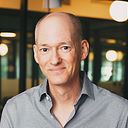The Waveform is a newsletter from me, Lee Schneider, the lead producer and founder of Red Cup Agency. When I have a new show to launch, or new episodes that I think you’ll like, I’ll drop you a note. If you aren’t on the list yet, go ahead and subscribe. Let’s get to it.
This week’s episode of How the River Flows is a conversation about big picture thinking about systems that happen to be forests.
You know what’s surprised me about producing How the River Flows? I never knew how generous forests can be. The wonky way to say this is that forests provide ecosystem services. For you and me, that means that forests can be where you take a hike or camp to reclaim yourself. They purify water and sequester carbon1, helping us with the climate crisis. When there is too much water, say during a heavy rain, forests handle the runoff, conserving the land.
The Original Social Network
Trees communicate with each other. They are social beings with families. Tree parents live with their children, talk to them, support them, and share nutrients with trees who are struggling.2
This week’s episode, hosted by Judy A. Takats of Keeping Forests, features Ken Arney, Regional Forester for the Southern Region of the U.S. Forest Service, Dr. Anne Murray Allen, an experienced executive in building effective collaborations in cross-sector work, and Scott Davis, who worked extensively in conservation at The Nature Conservancy.
Together, they cover the big thinking that led to creating the organization Keeping Forests and illuminate the relationship between healthy forests and clean water.
Listen on Apple Podcasts, Spotify, or wherever you listen to your favorite podcasts.
See you next time on The Waveform.
Lee
Red Cup Agency. Podcast Production.
Working with teams large and small, I take podcasts from the glimmer of an idea into production and distribution.
Here at The Waveform you won’t be tracked. I’m not tracking opens, clicks, or forwards. I’m not analyzing your IP address location. It’s just you and me, writing and reading. I’m trying to create a small part of the Internet that is focused just on people and dialog, not marketing data collection.
- A young tree absorbs about 5900 grams of CO2 per year, while a 10-year-old tree absorbs almost 22,000 grams per year. Source: Carbon Pirates. Here’s a list of good trees to plant for this purpose. ↩︎
- The Hidden Life of Trees will tell you a lot about the social life of trees and their communities. ↩︎
